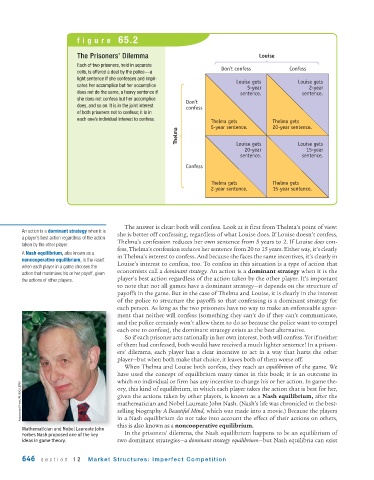Page 688 - Krugmans Economics for AP Text Book_Neat
P. 688
figure 65.2
The Prisoners’ Dilemma Louise
Each of two prisoners, held in separate Don’t confess Confess
cells, is offered a deal by the police—a
light sentence if she confesses and impli- Louise gets Louise gets
cates her accomplice but her accomplice 5-year 2-year
does not do the same, a heavy sentence if sentence. sentence.
she does not confess but her accomplice Don’t
does, and so on. It is in the joint interest confess
of both prisoners not to confess; it is in
each one’s individual interest to confess. Thelma gets Thelma gets
5-year sentence. 20-year sentence.
Thelma
Louise gets
20-year Louise gets
15-year
sentence. sentence.
Confess
Thelma gets Thelma gets
2-year sentence. 15-year sentence.
The answer is clear: both will confess. Look at it first from Thelma’s point of view:
An action is a dominant strategy when it is she is better off confessing, regardless of what Louise does. If Louise doesn’t confess,
a player’s best action regardless of the action
taken by the other player. Thelma’s confession reduces her own sentence from 5 years to 2. If Louise does con-
fess, Thelma’s confession reduces her sentence from 20 to 15 years. Either way, it’s clearly
A Nash equilibrium, also known as a in Thelma’s interest to confess. And because she faces the same incentives, it’s clearly in
noncooperative equilibrium, is the result
when each player in a game chooses the Louise’s interest to confess, too. To confess in this situation is a type of action that
action that maximizes his or her payoff, given economists call a dominant strategy. An action is a dominant strategy when it is the
the actions of other players. player’s best action regardless of the action taken by the other player. It’s important
to note that not all games have a dominant strategy—it depends on the structure of
payoffs in the game. But in the case of Thelma and Louise, it is clearly in the interest
of the police to structure the payoffs so that confessing is a dominant strategy for
each person. As long as the two prisoners have no way to make an enforceable agree-
ment that neither will confess (something they can’t do if they can’t communicate,
and the police certainly won’t allow them to do so because the police want to compel
each one to confess), the dominant strategy exists as the best alternative.
So if each prisoner acts rationally in her own interest, both will confess. Yet if neither
of them had confessed, both would have received a much lighter sentence! In a prison-
ers’ dilemma, each player has a clear incentive to act in a way that hurts the other
player—but when both make that choice, it leaves both of them worse off.
When Thelma and Louise both confess, they reach an equilibrium of the game. We
have used the concept of equilibrium many times in this book; it is an outcome in
which no individual or firm has any incentive to change his or her action. In game the-
Associated Press/PLINIO LEPRI ory, this kind of equilibrium, in which each player takes the action that is best for her,
given the actions taken by other players, is known as a Nash equilibrium, after the
mathematician and Nobel Laureate John Nash. (Nash’s life was chronicled in the best-
selling biography A Beautiful Mind, which was made into a movie.) Because the players
in a Nash equilibrium do not take into account the effect of their actions on others,
this is also known as a noncooperative equilibrium.
Mathematician and Nobel Laureate John
Forbes Nash proposed one of the key In the prisoners’ dilemma, the Nash equilibrium happens to be an equilibrium of
ideas in game theory. two dominant strategies—a dominant strategy equilibrium—but Nash equilibria can exist
646 section 12 Market Structures: Imperfect Competition

